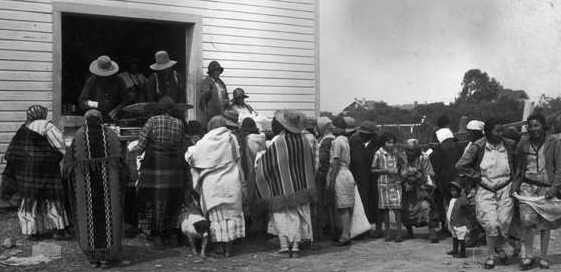The Ration Card: Ugly Remnant of How U.S. Decimated Indian Culture
Of the some 136 million objects and specimens in the grand Smithsonian collections, most carry an implied positive energy, or a promise of better things to come, or sometimes just simple joy. But there are also, though fewer, things of a darker mien, artifacts revealing caliginous corners of American history, including one so unimposing in size and materials as to appear insignificant; you could slip it into a shirt pocket, forget it’s there and run it through to its destruction in the wash.
About the size of a business card or a major-league bleachers ticket, this little piece of heavy, printed paper is the federal government’s substitute for the bison of the Great Plains, that source of life and culture that unknown thousands of aboriginal Americans depended on for generations beyond counting. Until the ghost dance generation—the one that kissed the old life goodbye to face an enemy future—the tribes that dominated the grasslands for 8,000 years fought most of their battles over bison hunting grounds. The red people ate bison, dressed in bison, imitated and talked to bison, and died for and by the sacred bison.
This ration ticket, this seeming inconsequential token of conquest and devastation, is the graphic expression of an 1883 act of Congress that furthered the appropriation of Indian lands west of the Missouri by moving tribal peoples onto assigned reservations, where, proclaims the act, “they may live after the manner of white men.” The reality was something else. The enforced reservation system meant native, nomadic tribes could live neither like white men—unless those whites were indigents—nor like the red men they had so recently been.
The ration ticket shown here was issued in the mid-1880s to someone called Woman’s Dress (perhaps, though not certainly, a female head of family), a member of the Oglala Lakota tribe quartered on the Pine Ridge reservation in the southwest corner of what is today South Dakota. Pine Ridge in our time lies almost in the shadow of Mount Rushmore and its four granite presidential physiognomies, none of whom would have perceived the sorrow resident in this paper faux-bison. The penned numeral nine probably indicates Woman’s Dress was allowed to draw rations of beef—and, also when available, beans, corn, flour, salt, and occasionally sugar, coffee, soap and tobacco—for nine dependents each Saturday.
Never mind that the flour and grains sometimes had gone moldy or that most of the Indians found the taste of beef no match for the rich flavor of bison. For these foreign and sorry substitutions, Indian men no longer able to support themselves sometimes had to perform labor. An Oglala Lakota once memorably said to me, “They take our land, they take our hunting and then they force us to work for food that made us sick.”
When this ticket was issued, the Plains bison had largely been exterminated, an extirpation heavily assisted by white hunters who would slaughter bison for nothing more than the delicacy of its tongue or merely for the pleasure of the kill. In the winter of 1884, government rations were so deficient on the Blackfoot reservation in Montana, the people suffered from malnutrition: A quarter of them died of starvation. They couldn’t eat paper.
Perhaps it was Woman’s Dress who decorated the ticket with a rawhide thong partly wrapped with dyed porcupine quills and finial cones of tin. I see that craft as an attempt to give it a touch of cultural meaning once rendered to a real bison, an attempt to turn a piece of bureaucracy and (ironically)red tape into something at least suggesting the sacred. Not uncommonly, Plains Indians also made beautifully decorated, cow-leather pouches to carry and protect their tickets. With quills and tin, the people tried to put a benign face on a graphic token of a blatantly imperialistic action worked upon those who had lived on the land for 15,000 years.
The lower third of the ticket, once imprinted with the dates for collecting rations, shows each numeral punched out with a hole in the shape of a cross. Whether that figure is deliberate, I don’t know, but it surely appears symbolic.
The degree of genuine humanity and generosity behind the rationing system is revealed by a remark in the 1850 Annual Report of the Commissioner of Indian Affairs: “It is, in the end, cheaper to feed the whole flock for a year than to fight them for a week.” Two years later, Gen. E. D. Townsend wrote in his California Diary of the Indians facing pressure from the 1849 gold rush: “If the tale of the poor wretches... could be impartially related, it would exhibit a picture of cruelty, injustice, and horror scarcely surpassed by that of the Peruvians in the time of Pizarro.”
A memoirist and novelist of English, Irish and Osage ancestry, William Least Heat-Moon says his research into 1880s Indian ration tickets was “some of the saddest work I’ve ever done.” This piece originally appeared in the November 2013 issue of SMITHSONIAN Magazine.





Comments
Post a Comment